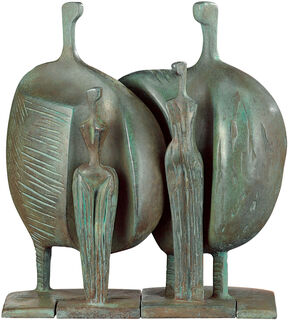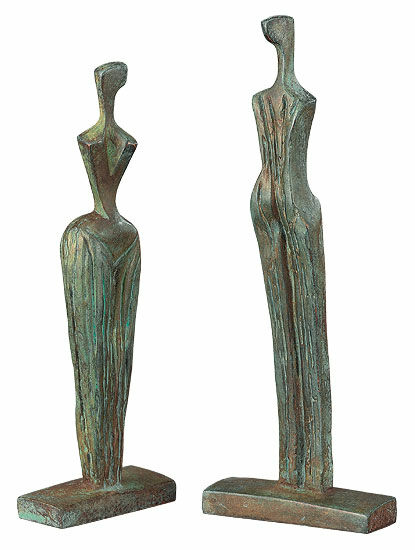Sculptural group "La Familia", bronze version
Sculptural group "La Familia", bronze version
Quick info
limited, 99 copies | numbered | signed | hallmarked | bronze | handmade | hand-patinated | height 17 - 26 cm | overall size 23 x 25 x 11 cm (w/h/d)
Detailed description
Sculptural group "La Familia", bronze version
Exclusively at ars mundi - a masterpiece by the artist Itzik Benshalom: "La Familia".
"La Familia" is a marvellous ensemble and a reflection of family life: each member, large or small, is a character in its own right and a work of art. But together, the four sculptures form a group of irresistible charisma - the family belongs together.
Patinated by hand. Each group is signed, numbered and hallmarked with the foundry stamp. Height of the individual sculptures from 17 to 26 cm, overall size 23 x 25 x 11 cm (w/h/d). Edition in fine bronze. Cast by hand using the Lost-Wax-Process. Limited edition of 99 copies.
About Itzik Benshalom
1945-2018
The sculptor Itzik Benshalom was born in Hadera, Israel. Benshalom preferred to work with bronze. His works, which always portray interpersonal relationships and interactions, adorn numerous public places and buildings and found their way into important art collections all over the world, such as the Boca Raton Museum of Art in Florida, the Grounds of Sculpture Museum in New Jersey, the Museum of Fine Art in Sherbrooke Quebec and the Flint Institute of Arts in Michigan.
Graphic or sculpture edition that was initiated by ars mundi and is available only at ars mundi or at distribution partners licensed by ars mundi.
Term for an art object (sculpture, installation), which is produced in multiple copies in a limited and numbered edition according to the artist‘s will.
Artist's multiples have been called the most accessible and affordable art on the market.
A plastic work of sculptural art made of wood, stone, ivory, bronze or other metals.
While sculptures from wood, ivory or stone are made directly from the block of material, in bronze casting a working model is prepared at first. Usually, it is made of clay or other easily mouldable materials.
The prime time of sculpture after the Greek and Roman antiquity was the Renaissance. Impressionism gave a new impulse to the sculptural arts. Contemporary artists such as Jorg Immendorf, Andora, and Markus Lupertz also enriched sculptures with outstanding works.












